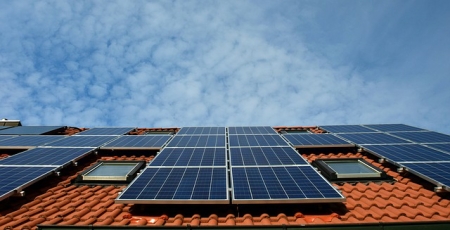VAT hike puts brakes on home solar and batteries

|
On Monday June 24, less than two weeks after outgoing Prime Minster Theresa May declared that the UK will achieve its new ‘Net Zero Carbon’ goal by 2050, a jubilant renewable energy industry was quickly pulled back down to earth. HMRC announced that, from October 1, 2019, VAT on home solar PV and solar-battery systems will increase sharply from 5% to 20%.
The PM’s net zero announcement positioned the UK as a world leader in the fight against climate change. This latest move, however, somewhat contradicts that commitment. It could also further destabilise the UK’s renewable energy industry, which was left wounded by the recent removal of the Feed-in Tariff.
Our net zero commitment still stands, of course, and it is still expected to herald more de-centralised renewable energy installations and accelerate the electrification of infrastructure, but the transition to a carbon-free future will be hampered by this VAT hike.
The labour component of solar and battery installations – the cheapest part – will remain taxed at 5%. The new rate will apply to material costs, which in general are the most expensive part of an installation. This will most likely have a negative effect on a key part of the energy mix needed to balance the grid and enable more ‘self-consumption’ by members of the public. Meanwhile (and worryingly for our net zero target), VAT rates for home gas and coal supplies will remain at 5%.
It is disappointing that, despite clear and definitive guidance from the Committee on Climate Change, and overwhelming consensus in the scientific community (and in the general population), the government still went ahead with this decision.
The official rationale is that, according to EU law ruled in 2015, the discounted tax rate was illegal to begin with. However, the government did not enact any changes to the VAT rate at the time, and the European Court of Justice has since published a VAT action plan (2016) without comment on solar power. It is perhaps telling that the new rates are due to come into effect the same month that the UK is to leave the EU.
ECA will continue to encourage government to make it clear how it intends to support industry in making the shift to a carbon-free future, and will continue to recommend actions that work for the benefit of both business and the environment.
[edit] About this article
This article was written by Luke Osborne, ECA Energy and Emerging Technologies Solutions Advisor. It was previously published on the website of the ECA in June 2019 and can be accessed here.
[edit] Related articles on Designing Buildings Wiki
- Battery energy storage systems with grid-connected solar photovoltaics BR 514.
- BRE National Solar Centre.
- BRE photovoltaic certification scheme.
- Code of practice for grid connected solar photovoltaic systems.
- Future of electricity in domestic buildings.
- Installation of photovoltaic panels on existing flat roofs - some lessons learned IP 8 14.
- Large scale solar thermal energy.
- Microgeneration.
- Micro-grid.
- Renewable energy sources: how they work and what they deliver: Part 4: Solar thermal hot water systems DG 532 4.
- Solar Squared.
- Solar thermal systems.
- Tau - the solar powered island.
- Wind loads on roof-mounted photovoltaic and solar thermal systems DG 489.
--ECA
Featured articles and news
Infrastructure that connect the physical and digital domains.
Harnessing robotics and AI in challenging environments
The key to nuclear decommissioning and fusion engineering.
BSRIA announces Lisa Ashworth as new CEO
Tasked with furthering BSRIA’s impressive growth ambitions.
Public buildings get half a million energy efficiency boost
£557 million to switch to cleaner heating and save on energy.
CIOB launches pre-election manifesto
Outlining potential future policies for the next government.
Grenfell Tower Inquiry announcement
Phase 2 hearings come to a close and the final report due in September.
Progress from Parts L, F and O: A whitepaper, one year on.
A replicated study to understand the opinion of practitioners.
ECA announces new president 2024
Electrical engineer and business leader Stuart Smith.
A distinct type of countryside that should be celebrated.
Should Part O be extended to existing buildings?
EAC brands heatwave adaptation a missed opportunity.
Definition of Statutory in workplace and facilities management
Established by IWFM, BESA, CIBSE and BSRIA.
Tackling the transition from traditional heating systems
59% lack the necessary information and confidence to switch.
The general election and the construction industry
As PM, Rishi Sunak announces July 4 date for an election.
Eco apprenticeships continue help grow green workforce
A year after being recognised at the King's coronation.
Permitted development rights for agricultural buildings
The changes coming into effect as of May 21, 2024.






















